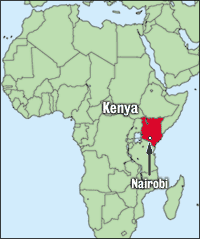|
|
|
|
|
|
|
|
 Collecting water, Nairobi (c) Betty Press/Panos Pictures |

Case study: Nairobi
The majority of Nairobi's urban population of 1.9 million lives in the vast shanty settlements that surround the central business district. Much of the land had been unused as it was prone to flooding, or because of the distance to amenities. Dirt roads become mud tracks in the rainy season and full of potholes in the dry. The lack of even the most basic amenities led to projects to improve urban services in five of the shanty districts with support from the World Bank. The poor's access to treated water improved, but crime and corruption kept costs high. To make water more accessible and affordable to the poor, the number of water kiosks increased in low-income areas from about 150 in 1978 to nearly 1,500 in 1994 and maintained a low tariff for kiosk operators. The increase in the number of kiosks reduced the distance to water sources, thus the time spent on obtaining water. Women in particular benefit from closer access, since they were the ones largely responsible for fetching water. A single kiosk sometimes serves as many as 50 households.
|

